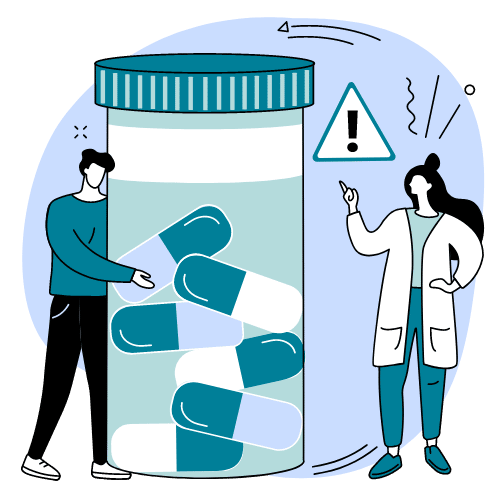How Many Drinks Is Too Many? How Much Is It Safe To Drink? And Other Common Questions
The issue of alcohol consumption is complex. As humans, we find great satisfaction in putting labels on things, sorting them into neat little boxes that help us keep our thoughts organized. Because of this, we tend to lump people who drink alcohol into one of two categories: those who have problems with alcohol and those who don’t.
As we know, issues in life are very rarely black-and-white, and there are many reasons why this type of thinking isn’t ideal. To put people who drink alcohol into one of those two categories ignores the subtleties and gray areas that exist in any issue that involves human biology and psychology. Because each person is different in the ways their body processes alcohol, it can be hard to determine how much alcohol is “too much” for people across the board. Because of this, guidelines for recommended alcohol consumption can vary widely. Even doctors and other medical professionals provide differing guidelines on daily alcohol consumption. Some say that drinking should always be limited to three alcoholic beverages per day. Others may preach the “1-2-3 Rule,” which means limiting alcohol consumption to one drink an hour, no more than two at once, and no more than three times per week. Many healthcare professionals simply suggest that their patients drink alcohol “in moderation.
Here at Swift River, we’ve compiled some frequently asked questions and answered them to help you better understand the complex issue of alcohol. We hope that these answers will help you remain safe and healthy by educating you on the dangers of excessive alcohol consumption. To give us a baseline for understanding, we must first ask:
What Qualifies as a Standard Alcoholic Drink?
The National Institute on Alcohol Abuse and Alcoholism (NIAAA) has determined what qualifies as standard alcoholic drinks to help with alcohol consumption guidelines. While their guidelines don’t apply to everyone, they do apply in the vast majority of cases. Let’s take a look at what qualifies as one alcoholic beverage. According to the NIAAA, a standard drink is equivalent to:
- 12 fl oz of beer (at 5% alcohol by volume)
- 8-9 fl oz of malt liquor (at 7% alcohol by volume)
- 5 fl oz of table wine (at 12% alcohol by volume)
- 1.5 fl oz or a shot of 80-proof distilled spirits (at 40% alcohol by volume)
It’s important to have these standard units in place when discussing how alcohol can affect the human body.
What Qualifies as “Heavy Drinking”?
Along with providing metrics for what makes up a standard drink, the NIAAA also has some guidelines that are used to determine whether a person is a “heavy drinker.” These guidelines are different for men and women, which we will discuss in the following section.
NIAAA defines heavy drinking as follows:
- For men, consuming more than 4 drinks on any day or more than 14 drinks per week
- For women, consuming more than 3 drinks on any day or more than 7 drinks per week
Clearly, there is a noticeable difference between the definition of heavy drinking for men versus for women. So it begs the question:
Why Do Alcohol Drinking Guidelines Vary So Much Between Men and Women?
To understand why there’s such a large difference in recommended alcohol consumption guidelines for men and women, we must first understand the ways in which our bodies metabolize (or process) alcohol. To make things simple: women’s bodies absorb and metabolize alcohol differently from the way men’s do. Women’s bodies are typically smaller, contain less body water, and have a higher liver-to-body-mass ratio (which leads to quicker metabolization of alcohol because the liver does most of the metabolizing). These factors work together to allow women to reach peak blood alcohol levels faster than men. That’s why the suggested weekly alcohol limit for women is half of that for men. (Of course, this is generalizing the issue as we know some men are smaller than some women, and vice versa.) Research also leads medical professionals to believe women are more vulnerable to alcohol-related organ damage than men. Compared with men, women develop alcohol-induced liver disease over a shorter period of time and after consuming less alcohol. In addition, women are more likely than men to develop alcoholic hepatitis and die from cirrhosis of the liver. Animal research suggests women’s increased risk of liver damage may be linked to the physiological effects of the female reproductive hormone estrogen.
What Other Factors Can Affect How Alcoholic Drinks Are Processed in the Body?
Along with the differences in the ways that men and women metabolize alcohol, there are some universal factors that can affect everyone. Some of these factors include: Body Weight: How much a person weighs is directly tied to the amount of alcohol they can consume before reaching dangerous levels. This becomes easy to understand when we take into account that up to 60% of the human body is composed of water. The larger the body, the more water it contains and the more alcohol will be diluted in the system. Think of it this way: When you put a drop of food coloring in a quart of water, it’s far more noticeable than if you put a drop in a gallon. Other Medications: Certain prescription and over-the-counter medications can have negative or unpredictable interactions with alcohol. This can work either way as some medications can either amplify or lessen the perceived effects of alcohol intoxication. Even if a medication seems to lessen the negative effects of alcohol consumption, blood alcohol content (BAC) can still reach dangerous highs. For example, many stimulant drugs such as Adderall or cocaine are thought to negate some of the negative feelings alcohol can create. This is a false perception of safety because an elevated BAC can still cause damage to the brain and organs. Eating Before or While You Drink: When someone eats a meal before or while drinking, it can act as a buffer between alcohol consumed and alcohol absorbed. It slows down the body’s ability to process alcohol. When someone drinks on an empty stomach, the alcohol can irritate the digestive system, causing more rapid alcohol absorption.
What Health Risks Go Along with Excessive Drinking?
Anyone who has gone through a hangover can attest that drinking to excess is not kind to the body and brain. Drinking too much at once can take a serious toll on a person’s health, and habitual excessive drinking can amplify these risks. Alcohol can have negative effects on every organ in the body, and logic correctly tells us that the intensity of alcohol’s negative effects is directly related to the amount of alcohol consumed. Some of the health risks associated with drinking too much include: Brain Damage: The headache that comes with a hangover may be the first sign that alcohol has a negative effect on the brain. Alcohol can disrupt neurotransmitters, or chemical messengers, in the brain. This causes impairment to the way the brain functions. These disruptions can lead to heavily impaired motor skills and unpredictable mood swings, as well as clouding the ability to think clearly and rationally. Heavy drinking over time can cause permanent brain damage and even alter the physical structure of the brain. Heart Disease: People who regularly consume alcohol to excess can cause permanent damage to their heart. This may lead to problems such as:
- Cardiomyopathy (weakening of the heart muscles)
- Arrhythmia or irregular heartbeat
- Stroke or heart attack
- Hypertension or increased blood pressure
Increased Risk for Certain Kinds of Cancers: Regular excessive alcohol consumption can also lead to an increased risk of developing certain cancers, including mouth, throat, liver, and breast cancers. Since alcohol is mainly consumed orally, all body parts that alcohol comes into contact with are at an increased risk of developing cancer.
So How Much Drinking Is Too Much?
As you may have gathered, the answer to this question is complicated and depends on a number of factors, including weight, liver function, sex, and more. The acceptable amount of alcohol consumption varies from person to person, but it’s important to keep in mind that at its best, the liver can only metabolize roughly one drink per hour. Casual alcohol consumption can quickly turn into alcohol use disorder if you aren’t careful. Each person is unique, and excessive drinking doesn’t always mean that someone is suffering from an alcohol use disorder. Although everyone is different, there are some universal signs to look out for when determining if you or a loved one is suffering from an alcohol use disorder. Look out for the following behaviors:
- The inability to limit drinking
- Continuing to drink despite negative effects on relationships and professional life
- Needing to drink more to obtain the desired effect
- Wanting to drink so badly that it becomes difficult or impossible to think of anything else
As a rule, drinking becomes a problem when it causes trouble in important aspects of life, such as personal relationships, work/school, social activities, or how a person thinks or feels.
Reclaim Control of Your Life at Swift River
At Swift River, we believe it is never too late for someone to begin their recovery from alcohol addiction or dependence. We’re here to provide compassionate, evidence-based alcoholism treatment. Admitting you or a loved one needs help for drinking can be scary, but it will take you one step closer to a healthier and happier future. Contact us today at 844-906-0978 to learn more.













